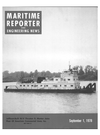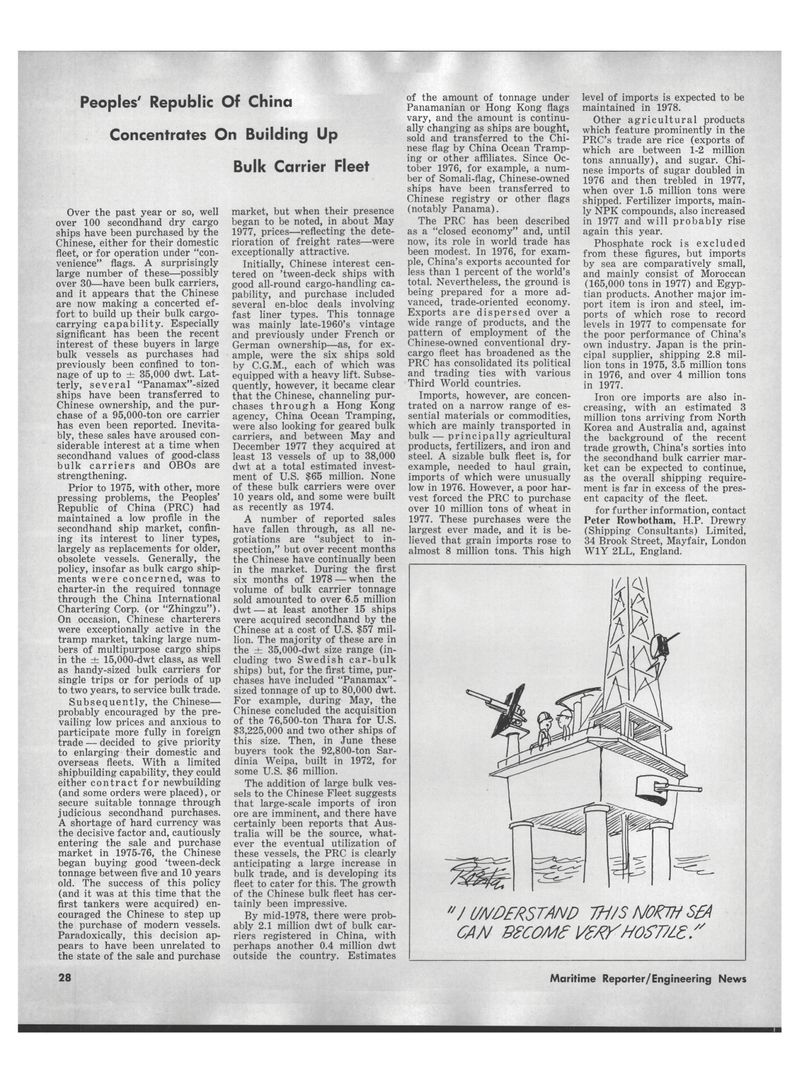
Page 26: of Maritime Reporter Magazine (September 1978)
Read this page in Pdf, Flash or Html5 edition of September 1978 Maritime Reporter Magazine
Peoples' Republic Of China
Concentrates On Building Up
Bulk Carrier Fleet
Over the past year or so, well over 100 secondhand dry cargo ships have been purchased by the
Chinese, either for their domestic fleet, or for operation under "con- venience" flags. A surprisingly large number of these—possibly over 30—have been bulk carriers, and it appears that the Chinese are now making a concerted ef- fort to build up their bulk cargo- carrying capability. Especially significant has been the recent interest of these buyers in large bulk vessels as purchases had previously been confined to ton- nage of up to ± 35,000 dwt. Lat- terly, several "Panamax"-sized ships have been transferred to
Chinese ownership, and the pur- chase of a 95,000-ton ore carrier has even been reported. Inevita- bly, these sales have aroused con- siderable interest at a time when secondhand values of good-class bulk carriers and OBOs are strengthening.
Prior to 1975, with other, more pressing problems, the Peoples'
Republic of China (PRC) had maintained a low profile in the secondhand ship market, confin- ing its interest to liner types, largely as replacements for older, obsolete vessels. Generally, the policy, insofar as bulk cargo ship- ments were concerned, was to charter-in the required tonnage through the China International
Chartering Corp. (or "Zhingzu").
On occasion, Chinese charterers were exceptionally active in the tramp market, taking large num- bers of multipurpose cargo ships in the ± 15,000-dwt class, as well as handy-sized bulk carriers for single trips or for periods of up to two years, to service bulk trade.
Subsequently, the Chinese— probably encouraged by the pre- vailing low prices and anxious to participate more fully in foreign trade — decided to give priority to enlarging their domestic and overseas fleets. With a limited shipbuilding capability, they could either contract for newbuilding (and some orders were placed), or secure suitable tonnage through judicious secondhand purchases.
A shortage of hard currency was the decisive factor and, cautiously entering the sale and purchase market in 1975-76, the Chinese began buying good 'tween-deck tonnage between five and 10 years old. The success of this policy (and it was at this time that the first tankers were acquired) en- couraged the Chinese to step up the purchase of modern vessels.
Paradoxically, this decision ap- pears to have been unrelated to the state of the sale and purchase market, but when their presence began to be noted, in about May 1977, prices—reflecting the dete- rioration of freight rates—were exceptionally attractive.
Initially, Chinese interest cen- tered on 'tween-deck ships with good all-round cargo-handling ca- pability, and purchase included several en-bloc deals involving fast liner types. This tonnage was mainly late-1960's vintage and previously under French or
German ownership—as, for ex- ample, were the six ships sold by C.G.M., each of which was equipped with a heavy lift. Subse- quently, however, it became clear that the Chinese, channeling pur- chases through a Hong Kong agency, China Ocean Tramping, were also looking for geared bulk carriers, and between May and
December 1977 they acquired at least 13 vessels of up to 38,000 dwt at a total estimated invest- ment of U.S. $65 million. None of these bulk carriers were over 10 years old, and some were built as recently as 1974.
A number of reported sales have fallen through, as all ne- gotiations are "subject to in- spection," but over recent months the Chinese have continually been in the market. During the first six months of 1978 — when the volume of bulk carrier tonnage sold amounted to over 6.5 million dwt — at least another 15 ships were acquired secondhand by the
Chinese at a cost of U.S. $57 mil- lion. The majority of these are in the ± 35,000-dwt size range (in- cluding two Swedish car-bulk ships) but, for the first time, pur- chases have included "Panamax"- sized tonnage of up to 80,000 dwt.
For example, during May, the
Chinese concluded the acquisition of the 76,500-ton Thara for U.S. $3,225,000 and two other ships of this size. Then, in June these buyers took the 92,800-ton Sar- dinia Weipa, built in 1972, for some U.S. $6 million.
The addition of large bulk ves- sels to the Chinese Fleet suggests that large-scale imports of iron ore are imminent, and there have certainly been reports that Aus- tralia will be the source, what- ever the eventual utilization of these vessels, the PRC is clearly anticipating a large increase in bulk trade, and is developing its fleet to cater for this. The growth of the Chinese bulk fleet has cer- tainly been impressive.
By mid-1978, there were prob- ably 2.1 million dwt of bulk car- riers registered in China, with perhaps another 0.4 million dwt outside the country. Estimates of the amount of tonnage under
Panamanian or Hong Kong flags vary, and the amount is continu- ally changing as ships are bought, sold and transferred to the Chi- nese flag by China Ocean Tramp- ing or other affiliates. Since Oc- tober 1976, for example, a num- ber of Somali-flag, Chinese-owned ships have been transferred to
Chinese registry or other flags (notably Panama).
The PRC has been described as a "closed economy" and, until now, its role in world trade has been modest. In 1976, for exam- ple, China's exports accounted for less than 1 percent of the world's total. Nevertheless, the ground is being prepared for a more ad- vanced, trade-oriented economy.
Exports are dispersed over a wide range of products, and the pattern of employment of the
Chinese-owned conventional dry- cargo fleet has broadened as the
PRC has consolidated its political and trading ties with various
Third World countries.
Imports, however, are concen- trated on a narrow range of es- sential materials or commodities, which are mainly transported in bulk — principally agricultural products, fertilizers, and iron and steel. A sizable bulk fleet is, for example, needed to haul grain, imports of which were unusually low in 1976. However, a poor har- vest forced the PRC to purchase over 10 million tons of wheat in 1977. These purchases were the largest ever made, and it is be- lieved that grain imports rose to almost 8 million tons. This high level of imports is expected to be maintained in 1978.
Other agricultural products which feature prominently in the
PRC's trade are rice (exports of which are between 1-2 million tons annually), and sugar. Chi- nese imports of sugar doubled in 1976 and then trebled in 1977, when over 1.5 million tons were shipped. Fertilizer imports, main- ly NPK compounds, also increased in 1977 and will probably rise again this year.
Phosphate rock is excluded from these figures, but imports by sea are comparatively small, and mainly consist of Moroccan (165,000 tons in 1977) and Egyp- tian products. Another major im- port item is iron and steel, im- ports of which rose to record levels in 1977 to compensate for the poor performance of China's own industry. Japan is the prin- cipal supplier, shipping 2.8 mil- lion tons in 1975, 3.5 million tons in 1976, and over 4 million tons in 1977.
Iron ore imports are also in- creasing, with an estimated 3 million tons arriving from North
Korea and Australia and, against the background of the recent trade growth, China's sorties into the secondhand bulk carrier mar- ket can be expected to continue, as the overall shipping require- ment is far in excess of the pres- ent capacity of the fleet. for further information, contact
Peter Rowbotham, H.P. Drewry (Shipping Consultants) Limited, 34 Brook Street, Mayfair, London
W1Y 2LL, England. " J l/WERSTAND Tfi/s MO/W S£A
CAN 9?C0M£ )/£/?/HOS7//£ 28 Maritime Reporter/Engineering News

 25
25

 27
27
